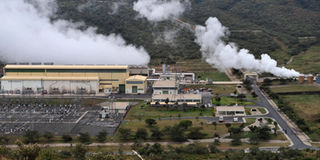Electricity giant opens EA shop

Olkaria Geotheraml plant. More than half the countries in Sub-Saharan Africa are estimated to have realised economic growth rates of not less than 5 per cent, a report shows. PHOTO/FILE
What you need to know:
- Emergency power has the impact of increasing the cost of energy to cater for the generators’ margins, especially in the case of electricity which is produced using diesel, whose price fluctuates according to changes in the international oil prices.
A Dubai-based emergency power producer has opened a branch in Nairobi to serve the regional market.
In a statement, Altaaqa Global CAT Rental Power said the regional office will serve Kenya, Tanzania, Uganda, South Sudan, and Burundi, which are currently struggling to meet local demand for electricity.
Its entry into the Kenyan market might result in a comeback of expensive diesel-driven emergency power to the national grid should the company’s services be contracted by the government.
Emergency power has the impact of increasing the cost of energy to cater for the generators’ margins, especially in the case of electricity which is produced using diesel, whose price fluctuates according to changes in the international oil prices.
“Businesses in East Africa are flourishing and the economy has been thriving throughout recent years, resulting in an increased demand for power. Our objective is to be on the ground as quickly as possible. Our new branch will enable us to reach this region faster than before,” said Altaaqa Global general manager Peter den Boogert.
The company will ride on its existing 1,400 megawatt capacity to satisfy its customers, he noted.
Mr Steven Meyrick, a board representative of Altaaqa Global, added that in its growth strategy covering the period up to 2020, the company will invest in additional generators to produce power on various platforms such as natural gas, liquefied natural gas (LNG), compressed natural gas, and heavy fuel oil.
Kenya, under the mega plan to add 5,000 megawatts of electricity to the national grid in a period of 40 months starting September 2013, is exploring the use of LNG and coal.
This is in addition to renewable sources of power such as wind, solar, and geothermal energy that are hoped to shift the country’s reliance on hydro resources which rely on weather conditions.
According to the International Monetary Fund, East Africa has encouraging economic growth prospects, aided by the recent discovery of minerals and fossil fuels.
It is expected that this anticipated growth will accelerate industrialisation of the area and calls for major plans to tackle frequent shortage of electricity supply.
The current total installed electricity generating capacity in Kenya is about 1,600 megawatts. This comprises plants operated by the government-owned Kenya Electricity Generating Company and independent power producers (IPPs).
According to Kenya Power, the national power distributor, this capacity is not enough to meet the country’s demand.
In the past, the government supplemented local power generation with 120 megawatts of diesel-driven emergency power from UK’s Aggreko. In September last year, this capacity was reduced to 30 megawatts as the government preferred cheaper electricity from IPPs not relying on diesel.
However, in November last year, Aggreko’s contract for 30 megawatts of emergency power was extended for six months to serve the Western region, whose supply remains unstable.





